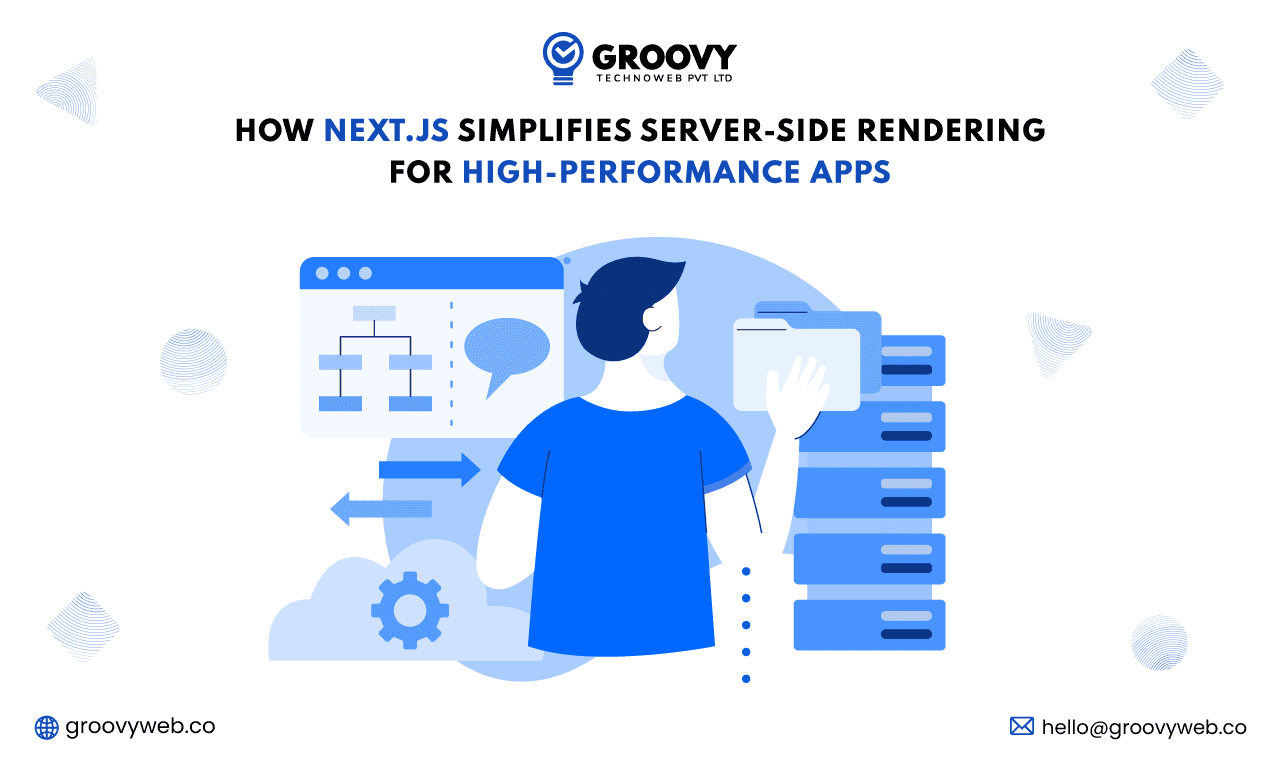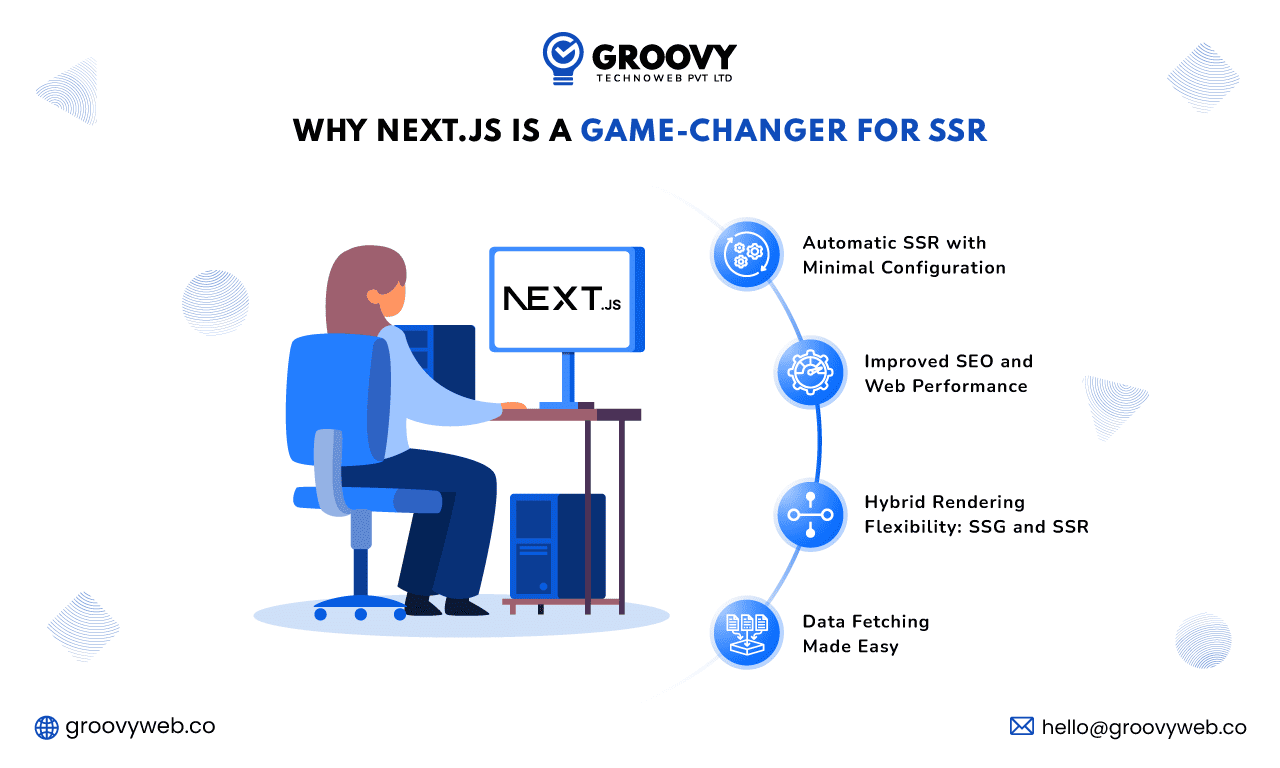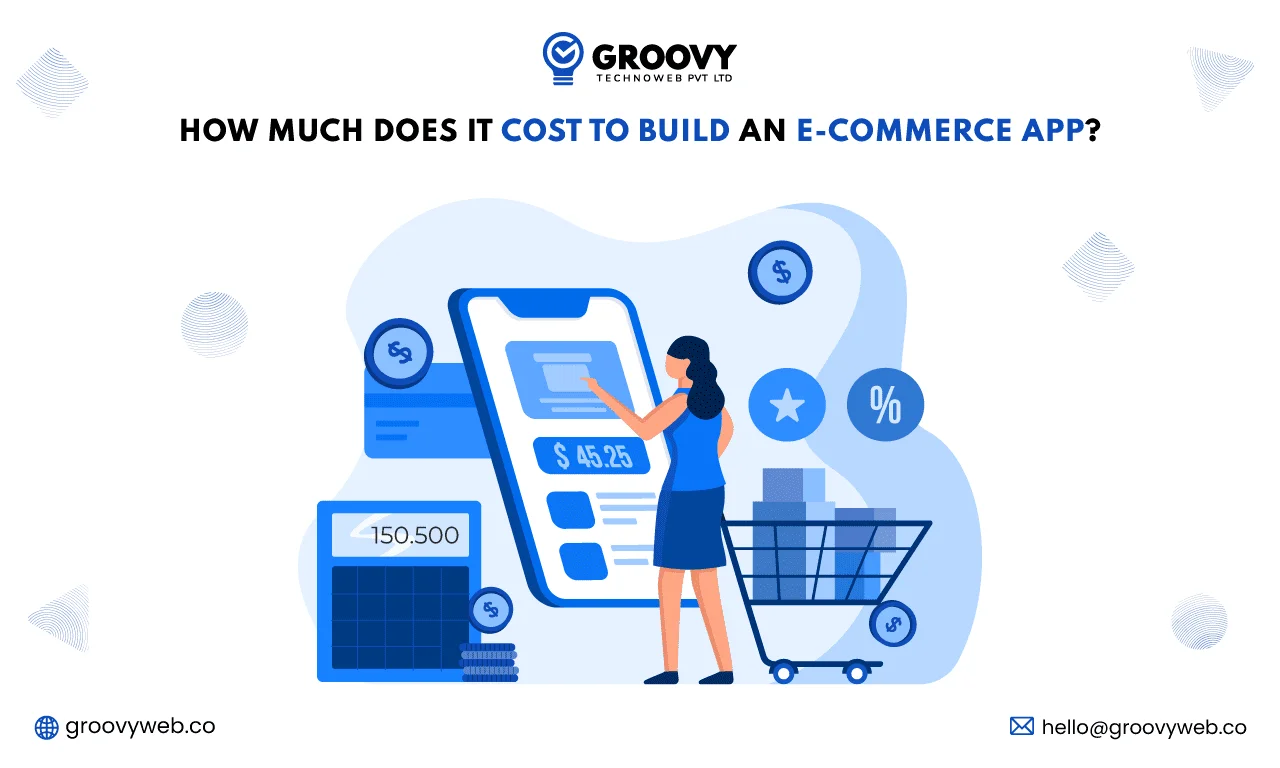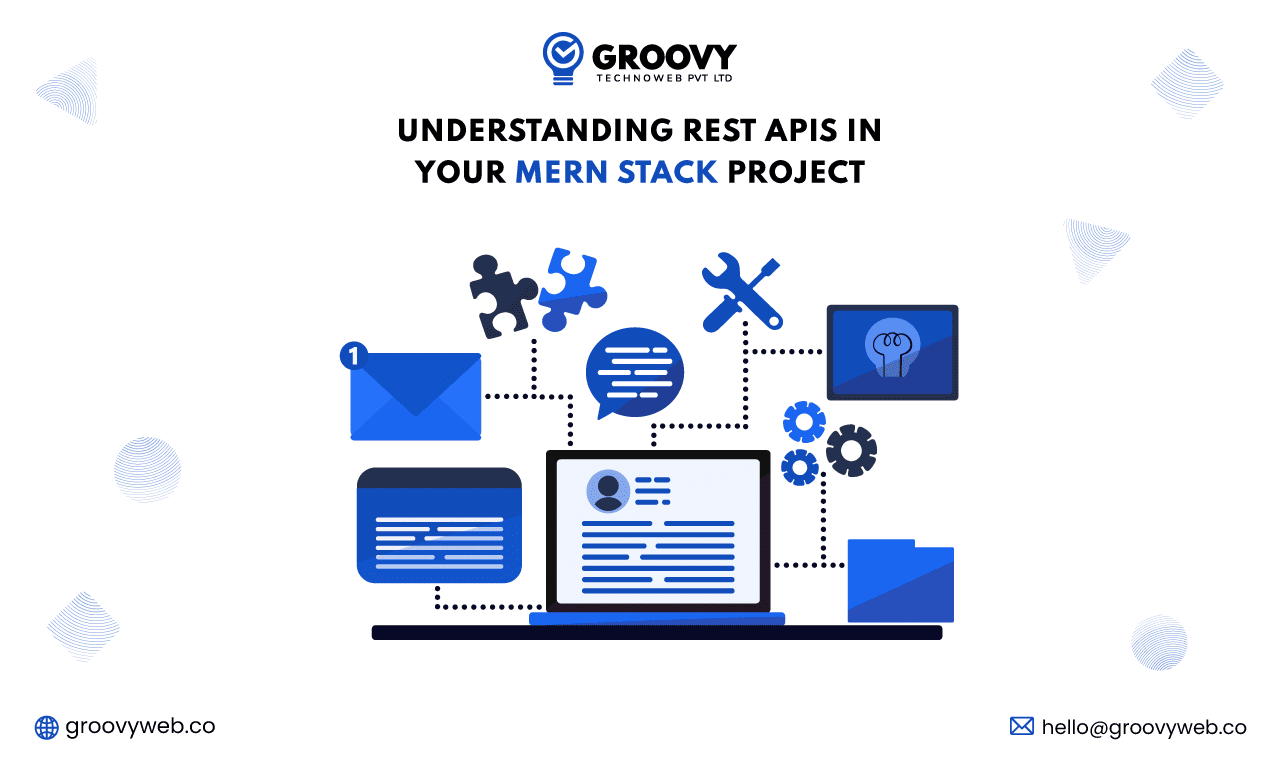How Next.js Simplifies Server-Side Rendering for High-Performance Apps
Nauman Pathan
December 07, 2024 280 Views
Quick Summary : Next.js simplifies SSR forcing minimal and automatic SSR for React JS app development hence enhancing its performance and SEO. It utilizes both the SSR and SSG approaches which makes it efficient in loading static and dynamic content. These include features like automatic code splitting for optimized performance, automated image optimization, and even predefined API routes which make Next.js a perfect tool for creating full-stack applications capable of handling large traffic loads. Next JS development services can help businesses improve web performance and scalability.
As we know nowadays time is more precious and in between online and offline modes, the user experience and performance play a more important role for the web application, to fulfill those requirements the developers are moving towards server-side rendering (SSR). Next.js is a framework built on React and has now become a unique solution that simplifies SSR for high-performance applications. It provides flexible tool sets for rendering the code, fast loading rates, and great usability, making it suitable for different businesses seeking effective web development services.
Here, in this blog, let us create an understanding of how Next js development services aid in making SSR easier, thereby understanding why it is such a powerful tool for building apps that are future-proofed for scalability and performance enhancement. It will also describe its effectiveness in resource usage in React applications while enhancing productivity in React JS app development.
Understanding Server-Side Rendering (SSR)
It is necessary to begin with an explanation of what SSR is and why it is significant before touching upon how Next.js makes it easier.
Server-side rendering is a technique whereby the web server generates HTML for a particular page before sending it to the client browser. This is different from the client-side rendering (CSR) where the browser requests the JavaScript and then downloads and renders the contents of the updated page. For example, in SSR, the user gets a complete HTML page that is faster to load and is preferred by Bing and Google to crawl through the content.
The Benefits of SSR
- Faster Load Times: SSR reduces the duration before the user sees the first useful content in the viewport, which is beneficial, especially when connected to ineffective networks.
- Better SEO: Search engines have a preference for server-side rendering because it can be easier for them to read HTML. This makes SSR especially suitable for websites that require strong optimization of a search.
- Enhanced User Experience: The server-side rendering makes a page load faster and, therefore, shortens the time a user spends looking at a blank screen with the app loading, increasing its interaction.
The Impact of Server-Side Rendering on Performance
Server-side rendering has emerged as one of the essential approaches in web development for efficiency. Specifically, SSR is a process where a web page is rendered on the server before it is delivered to the client’s browser. This leads to quick and better loading, search engine optimization, and optimal usage from clients especially for dynamic web applications. Overall, when it comes to performance-oriented applications particularly those created with React, adding in the process of SSR is sometimes difficult to manage and can be time-consuming.
This is where Next.js comes in. In so doing, it simplifies the creation and implementation of high-performance, easy-to-scale applications that seamlessly adapt to SSR.
Why Next.js is a Game-Changer for SSR

Automatic SSR with Minimal Configuration
One of the standout features of Next.js is that it comes with built-in support for server-side rendering with no need for configuration. Developers no longer need to set up complicated build tools because Next.js handles the server and client-side utilities independently so that the developers can concentrate on the application itself.
Consequently, businesses can adopt Next.js development services to implement effective and scalable applications while avoiding the complexities for configurations. For organizations that may require unique solutions, Next.js allows them to design and deliver outstanding user experiences.
Improved SEO and Web Performance
SEO is typically a problem that is faced by client-side rendered applications where search engines are likely to fail at crawling sites that heavily use JavaScript. With Next.js, pre-rendering options guarantee a fully rendered HTML to the search bots, thus enhancing the site’s discoverability and ranking.
Aside from improving SEO, Next.js also improves the overall performance of the web by having efficient rendering, decreasing FCP time. This makes page loading faster for the users which is very useful for applications that contain a lot of content such as e-commerce sites, blogs, and news sites. Next.js development services bring the advantage of enhanced organic traffic and increased engagement, which can result in higher conversions for those firms that choose to integrate them.
Hybrid Rendering Flexibility: SSG and SSR
Another significant feature that makes Next.js highly customizable is the ability to apply both server-side and client-side rendering depending on needs. It enables the use of Static Site Generation (SSG) for such pages that do not frequently update, while Server-Side Rendering (SSR) is utilized in pages that need constant updates or contain dynamic data.
This combination allows for the development of applications that can benefit from both of these approaches. For example, a product listing page on an e-commerce platform can be created and served statically for faster loading, while other sections such as a user profile page will be rendered on the server. For this reason, Next.js development services are ideal for companies that need a unique approach to web development that involves both static and dynamic content.
Data Fetching Made Easy
Data fetching is a fundamental aspect of modern web applications, and Next.js makes it relatively easy. Several in-built methods within the framework allow data to be fetched from APIs, databases, or external services, to make data available when it is required and as it is rendered on the server.
This improves performance and offers a great end-user experience when the content is made to load and render quickly. Businesses that engage in the services of Next.js development can be assured that the applications that will be developed from the platform will handle large instances of data. Also, it will load and process several instances of data concurrently without any reduction in the rates at which they will be able to perform these functions.
Optimized Image Handling for Faster Loading
While images are one of the primary culprits when it comes to the total size of the web resources, especially in content-intense or media-intensive applications, they are commonly a type of resource that turns out to be a Web performance issue. To tackle this issue, Next.js has integrated an image optimization tool that can help avoid such problems. This feature optimizes images for display depending on the device and the network connection of the user to minimize the time taken to display the images thus improving its performance.
In the case of e-commerce websites or applications that heavily rely on media content, this can be a significant issue affecting user experience and their decision to purchase. With Next.js development services, businesses can be relieved knowing that their applications have a rapid and user-friendly front end, especially when handling huge media content.
Code Splitting and Bundle Optimization
One of the most crucial problems developers normally encounter when working at the app’s scale is how to handle the bundles. Big bundles can slow down page loads and even the performance of the whole application. Next.js solves this problem through automatic code splitting where only the required code for a given page is loaded.
This leads to quicker response times and less consumption of resources, especially when accessed through a low bandwidth connection. It is extremely useful for companies that require the ability to scale applications while maintaining fast performance, making Next.js an excellent solution for React JS app development.
Simplified Routing
Traditional React applications are usually handled by extra libraries, but, in the Next.js framework, it is achieved through file-based routing. This means that each file that is placed in the pages/ directory is a route by default, and there is no need for complicated routing configurations.
This can make development time faster and there are fewer errors, allowing application developers to create scalable, high-performance apps while not worrying about routing configuration. For businesses seeking solutions in website development, this enhanced routing approach makes it easier to establish and maintain web applications.
Built-In API Routes for Full-Stack Applications
An additional strong aspect of Next.js is the possibility of generating API routes inside the application itself. This makes it possible for developers to create a complete application without having to use another framework for the backend. Every API route is considered a serverless function, making it easy to develop and deploy APIs.
For those companies that are looking for Next.js development services, it means opportunities for creating strong applications that manage the business logic of both the front end and the back end. No matter whether it is a contact form, a simple web application, or a complex data-driven application, Next.js gives the set of tools to create, deploy, and manage the application effectively.
Why Businesses Should Choose Next.js for Custom Web Development?
Scalability
Next.js is optimized for scaling with high-traffic applications and can manage the flow of traffic quite easily. Its performance optimization methods, such as the service worker, routing, code, and image optimization, make it suitable for custom web development services that are likely to grow in size without increasing complexity or slowing response times.
If you are a business aiming to scale up your online presence, it is highly advisable to work with Next.js development services. There is a guarantee that your application shall be scalable to take on rising peak traffic and data throughput without much redesigning or reengineering.
Enhanced Developer Experience
The fact that Next.js offers simplicity and effectiveness of many programming methodologies cannot be underestimated. All these considerations remove the developer’s guesswork along with many of the typically required manual configurations, simplify the routing, and even give built-in API routes, as well as other capabilities such as data fetching.
It not only increases the rate of development or minimizes the risk of encountering problems in the course of creating the application, but it also makes the application more secure. In this sense, for businesses, it means faster time-to-market and lower development costs, making Next.js a cost-effective framework for building custom projects.
Integration with Third-Party Services
Being a React framework, Next.js readily connects with numerous third-party services including CMS applications, analytics, and e-commerce platforms. This reduces the level of integration or migration associated with implementing an existing system in a Next.js business application.
Next.js is a great option for businesses in search of React JS app development services because it provides the needed freedoms to construct an application in a way that these businesses can grow and overcome challenges in the technologies of operating systems.
Conclusion
Next.js has made a significant transformation in the process of server-side rendering and high-performance applications. Its capability to work with SSR out-of-the-box while including things like SSG, data fetching, image processing, and code splitting makes it one of the best tools for creating fast, highly scalable, and SEO-optimized applications.
For companies seeking customized web development solutions, a Next.js development company provides unmatched flexibility, speed, and adaptability to meet the ever-changing demands of the market. Whether you need an e-commerce platform, an informational website, or a sophisticated web application, Next.js delivers robust features and configurations to ensure your project achieves optimal performance and exceptional user experience.
Interestingly, by integrating Next.js and collaborating with highly skilled React JS app development companies, organizations stand the best chances of developing highly effective applications that are capable of serving clients’ needs most efficiently, eventually leading to business success and growth in the fast-evolving digital world.
Written by: Nauman Pathan
Nauman Pathan is a Project Manager at Groovy Web - a top mobile & web app development company. He is actively growing, learning new things, and adapting to new roles and responsibilities at every step. Aside from being a web app developer, he is highly admired for his project management skills by his clients.
Frequently Asked Questions
We hope these clear your doubts, but if you still have any questions, then feel free to write us on hello@groovyweb.coHow does Next.js enhance SEO for React applications?
A key way that Next.js boosts SEO is the process of server-side rendering which involves delivering fully rendered HTML string rather than heavy JavaScript to the crawlers. This helps search engine crawlers to easily crawl through your webpages which boosts its visibility as well as its rankings. In the case of SEO-sensitive websites such as online stores, blogs, or applications with extensive content, Next.js is an efficient solution for increasing traffic from organic search.
What is the benefit of having SSR along with SSG in Next.js?
Next.js provides a way to choose between SSR for more frequent changes and server-rendered pages and SSG for infrequently changing pages and blogs. This bifunctional feature allows for the delivery of static pages efficiently while maintaining the relevancy of dynamic data for each user request. The result is improved performance where users can see good loading time for static content and real-time data for dynamic pages balancing between the two to give the best results in performance and scalability.
What is the process of enhancing web quality particularly for heavy traffic applications in Next.js?
Next.js optimizes the application by preloading only the necessary dependencies for a page and splitting code as well as creating small JavaScript bundles for a page. It also has the option to optimize images to reduce the loading size depending on the user’s device and connection, making it more responsive. With the ability to pre-render content during build time or dynamically, it is possible to provide users with fully pre-rendered pages which is why Next.js is appropriate especially for sites that are expected to have heavy traffic.
Is Next.js available for full-stack applications?
Yes, Next.js supports full-stack development because it provides API route features for developers to build backend capabilities from the same application. These API routes are used like serverless functions which makes developing of APIs easier compared to setting them up with another separate framework. This helps developers manage all the logic related to both the front end and back end in a single codebase, facilitate the development work, and avoid the need for external servers while making the systems easily scalable and maintainable.
Related Blog

Rahul Motwani
How Much Does It Cost to Build an ecommerce App?
Mobile App Development 23 Jan 2025 10 min read
Ashok Sachdev
How to Estimate Your App Development Cost Effectively
Mobile App Development 31 Mar 2025 13 min readSign up for the free Newsletter
For exclusive strategies not found on the blog
